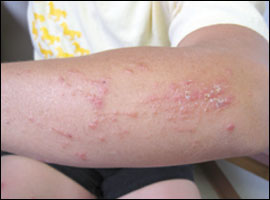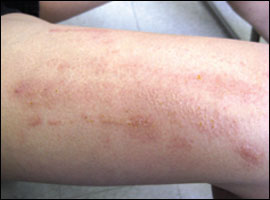
Am Fam Physician. 2009;79(10):901-902
Author disclosure: Nothing to disclose.
A 56-year-old woman presented with a rash on her arms and legs (Figures 1 and 2) that had persisted for one week. The patient had recently done yard work while wearing shorts and a T-shirt. The day after working in her yard, she felt extreme heat and pruritus on her forearm. She developed lesions of varying size on her arms and legs. The largest lesion had linear streaks and appeared on her right thigh. Some lesions had vesicles that had burst and crusted over. Intermittent application of topical antihistamines and hydrocortisone cream was ineffective.


Question
Discussion
The answer is A: allergic contact dermatitis. Plant-related contact dermatitis most commonly occurs from exposure to poison ivy, poison oak, or poison sumac.1 Previously these plants were categorized in the genus Rhus, hence the term rhus dermatitis. They have been reclassified in the genus Toxicodendron. Plants in this genus contain the chemical urushiol, to which up to 70 percent of the population may be sensitized.2
The clinical presentation of the contact dermatitis varies depending on the patient's sensitivity and the amount of exposure to the allergen. The pruritic rash is typically erythematous with papular lesions in a linear pattern. Papules and vesicles develop and may enlarge into bullae and plaques. Skin thickness on the palms prevents eruptions, but other areas of the extremities are commonly affected. A history of plant exposure or outdoor activities may suggest contact dermatitis. Lesions usually appear within 12 to 48 hours of exposure in a previously sensitized person. Topical steroids are effective in treating early or limited lesions. Antihistamines and cool compresses with Burow solution may be used to relieve the pruritus. Oral steroids may be needed if the rash is severe. Physicians should consider longer tapers of oral steroids because symptoms often require a longer duration of treatment than the short courses prescribed in bursts or dose packs provide. The patient in this presentation used over-the-counter topical medications, which were ineffective because of the area of skin involved and the short duration of her self-treatment.
Patients with atopic dermatitis often have a personal or family history of asthma or allergic rhinitis. The rash is characterized by pruritus and xerosis and consists of red, elevated, scaly, often oozing or excoriated plaques on the flexor surfaces of the body.3 Treatment consists of antihistamines and steroids.
Chemical burns cause redness, irritation, or burning immediately after contact with the substance. Pain and numbness may develop, as well as blisters or gangrene. Treatment consists of wound irrigation and topical antibiotics.4
Dyshidrotic eczema is also commonly known as pompholyx. The condition may be acute, recurrent, or chronic. Itching or burning of the hands, feet, or both occurs several hours before the eruption of vesicles.5 Vesicles initially appear on the lateral aspects of the fingers, followed by the palms, soles, and plantar surfaces of the hands and feet. Eruptions are often bilateral and symmetric. Treatment is similar to that of allergic contact dermatitis, consisting of Burow solution and topical or oral steroids.
Neurotic excoriations are self-inflicted skin lesions from repetitive scratching. The lesions are usually clean, linear erosions with eschar and scars. They are often similar in size and shape, and appear on exposed areas of the body, such as the extensor surfaces of the extremities, face, and upper back.6 Treatments include counseling and psychotropic medications.
| Condition | Characteristics |
|---|---|
| Allergic contact dermatitis | Pruritic, asymmetric, linear rash on exposed skin with vesicle formation |
| Atopic dermatitis | Pruritus and xerosis; red, elevated, scaly, often oozing or excoriated plaques on flexor surfaces |
| Chemical burn | Pruritic, red, burning, blistering rash immediately after contact with substance |
| Dyshidrotic eczema | Pruritic, bilateral, symmetric rash with vesicular development on palms, soles, and plantar surfaces of hands and feet |
| Neurotic excoriations | Self-inflicted linear rash with eschar and scars on exposed areas of the body |